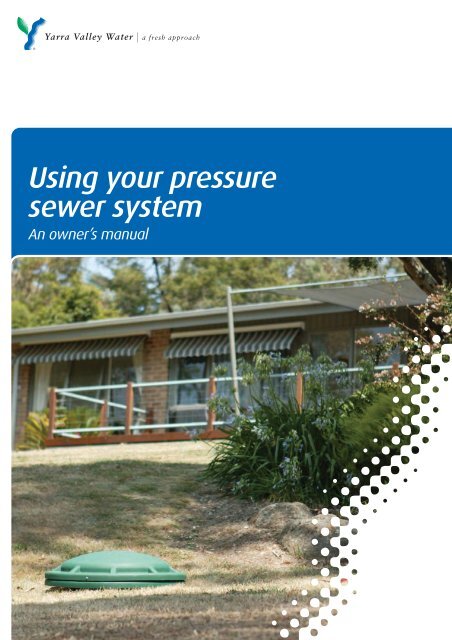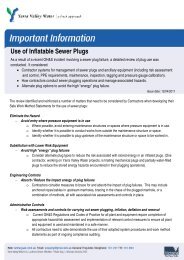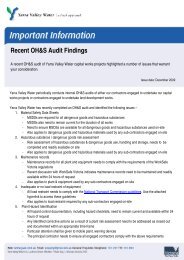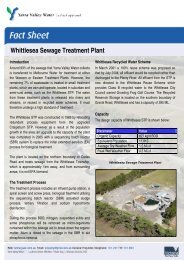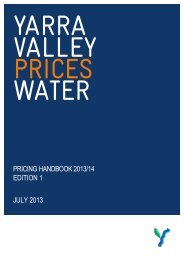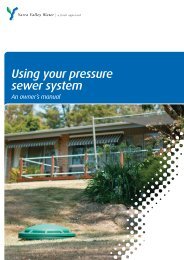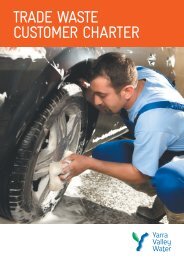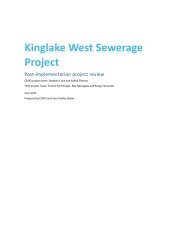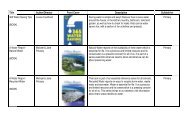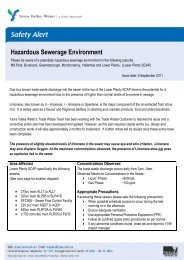What do I need to know about pressure sewer systems?
What do I need to know about pressure sewer systems?
What do I need to know about pressure sewer systems?
Create successful ePaper yourself
Turn your PDF publications into a flip-book with our unique Google optimized e-Paper software.
Using your <strong>pressure</strong><br />
<strong>sewer</strong> system<br />
An owner’s manual
Using this manual<br />
This manual is a guide <strong>to</strong> the operation and maintenance of the <strong>pressure</strong> <strong>sewer</strong> system<br />
installed on your property. The system is easy <strong>to</strong> use and we strongly recommend that<br />
you take a few minutes <strong>to</strong> familiarise yourself with how it works.<br />
There are some basic things that you should <strong>know</strong> <strong>about</strong> your <strong>pressure</strong> <strong>sewer</strong> system.<br />
These include:<br />
• how <strong>to</strong> care for your unit<br />
• what happens if the alarm sounds<br />
• what procedures <strong>need</strong> <strong>to</strong> be put in place before you go on holiday.
Contents<br />
Using this manual<br />
<strong>What</strong> <strong>do</strong> I <strong>need</strong> <strong>to</strong> <strong>know</strong> <strong>about</strong> <strong>pressure</strong><br />
<strong>sewer</strong> <strong>systems</strong><br />
Why install a <strong>pressure</strong> <strong>sewer</strong> system<br />
<strong>What</strong> is a <strong>pressure</strong> <strong>sewer</strong><br />
<strong>What</strong> components make up a <strong>pressure</strong><br />
<strong>sewer</strong> system<br />
2<br />
3<br />
3<br />
3<br />
3<br />
How <strong>do</strong> <strong>pressure</strong> <strong>sewer</strong> <strong>systems</strong> work 4<br />
Important information<br />
<strong>What</strong> items must NOT be flushed <strong>do</strong>wn your household drains<br />
Why can’t rainwater go in<strong>to</strong> the <strong>pressure</strong> <strong>sewer</strong> system<br />
Why must I keep heavy weights off the lid<br />
5<br />
<strong>What</strong> happens if I want <strong>to</strong> extend my house<br />
or landscape the garden<br />
6<br />
House service line<br />
6<br />
Extensions <strong>to</strong> your house<br />
6<br />
Bungalows or other dwellings on your property 6<br />
Landscaping<br />
6<br />
Garages, car parks, decking, and garden sheds 6<br />
Installing a swimming pool or large spa<br />
6<br />
<strong>What</strong> special precautions <strong>do</strong> I <strong>need</strong> <strong>to</strong> take<br />
when going on holidays<br />
Going on holidays<br />
7<br />
7<br />
<strong>What</strong> you <strong>need</strong> <strong>to</strong> <strong>know</strong> <strong>about</strong> alarms 8<br />
Why is my alarm going off<br />
8<br />
Pumping unit repairs and warranties 9<br />
<strong>What</strong> happens if my pumping unit <strong>need</strong>s <strong>to</strong> be repaired 9<br />
Pumping unit servicing<br />
9<br />
Pressure <strong>sewer</strong> bursts<br />
9<br />
Warranties<br />
and repair costs<br />
9<br />
Conditions<br />
of connection<br />
10<br />
Using your <strong>pressure</strong> <strong>sewer</strong> system<br />
1
<strong>What</strong> <strong>do</strong> I <strong>need</strong> <strong>to</strong> <strong>know</strong> <strong>about</strong> <strong>pressure</strong> <strong>sewer</strong> <strong>systems</strong><br />
Why install a <strong>pressure</strong> <strong>sewer</strong><br />
system<br />
Pressure <strong>sewer</strong> <strong>systems</strong> are an economical<br />
and environmentally-friendly way of<br />
collecting, transporting and disposing of<br />
wastewater from households. They are often<br />
used in areas when the landscape is either<br />
very hilly or very flat, in areas which regularly<br />
flood or have high water tables, or where<br />
it is impractical <strong>to</strong> install other types of<br />
<strong>sewer</strong>age <strong>systems</strong>.<br />
<strong>What</strong> is a <strong>pressure</strong> <strong>sewer</strong><br />
system and how <strong>do</strong>es it work<br />
A <strong>pressure</strong> <strong>sewer</strong> system is made up of a<br />
network of fully sealed pipes which are fed by<br />
pumping units located at each connected<br />
property.<br />
The pumping unit processes the household<br />
wastewater and transfers it <strong>to</strong> the <strong>pressure</strong><br />
<strong>sewer</strong> located in the street via a small<br />
pipeline within the property. The <strong>pressure</strong><br />
<strong>sewer</strong> forms part of the overall pipe network<br />
which ultimately transfers the wastewater <strong>to</strong><br />
the nearest wastewater treatment facility –<br />
this could be within the surrounding area or<br />
many kilometers away.<br />
Once installed, the only visible parts of the<br />
<strong>pressure</strong> <strong>sewer</strong> system are the tank lid and<br />
control panel (see above).<br />
<strong>What</strong> components make up<br />
a <strong>pressure</strong> <strong>sewer</strong> system<br />
The <strong>pressure</strong> <strong>sewer</strong> system on your property<br />
is made up of four key elements, as shown<br />
in the diagram below.<br />
Pressure <strong>sewer</strong> system components<br />
1. Pumping unit<br />
This includes a small pump, s<strong>to</strong>rage tank,<br />
and level moni<strong>to</strong>rs which are all installed<br />
underground so that only the <strong>to</strong>p of the<br />
s<strong>to</strong>rage tank (or lid) is visible.<br />
street<br />
2<br />
Yarra Valley Water ownership<br />
cus<strong>to</strong>mer property<br />
lid<br />
capped<br />
inspection<br />
opening<br />
(27A)<br />
cus<strong>to</strong>mer<br />
ownership<br />
4<br />
2. Boundary valve kit<br />
Ensures that wastewater which is already<br />
in the <strong>pressure</strong> <strong>sewer</strong> cannot re-enter your<br />
property and enables maintenance staff <strong>to</strong><br />
isolate you from the system in the event of<br />
an emergency.<br />
3. House service line<br />
This is a small diameter pipe (not dissimilar<br />
<strong>to</strong> a large sprinkler system pipe) which<br />
connects the pumping unit on your property<br />
<strong>to</strong> the <strong>pressure</strong> <strong>sewer</strong> in the street.<br />
s<strong>to</strong>rage tank<br />
3<br />
<strong>pressure</strong><br />
<strong>sewer</strong><br />
boundary<br />
valve kit<br />
1<br />
pump<br />
riser<br />
property<br />
drain<br />
4. Control Panel<br />
This is a small box which is mounted <strong>to</strong><br />
the wall of your house containing all the<br />
electrical controls for the pumping unit<br />
including both the audible and visual<br />
alarm <strong>systems</strong>.
Pressure <strong>sewer</strong> <strong>systems</strong> are an economical<br />
and environmentally-friendly way of<br />
collecting, transporting and disposing of<br />
wastewater from households.<br />
How <strong>do</strong> <strong>pressure</strong> <strong>sewer</strong> <strong>systems</strong> work<br />
The main component of the <strong>pressure</strong> <strong>sewer</strong> system is the pumping unit which<br />
is installed on your property. The pumping unit works in the following way:<br />
STEP 1<br />
STEP 2<br />
Wastewater enters the<br />
s<strong>to</strong>rage tank from the<br />
household drains<br />
(including sinks, <strong>to</strong>ilets,<br />
showers, baths etc.)<br />
Alarm level<br />
Pump on<br />
The wastewater level<br />
rises above the “pump<br />
on” level and the pump<br />
au<strong>to</strong>matically turns on.<br />
Alarm level<br />
Pump on<br />
Pump off<br />
Pump off<br />
Water<br />
level<br />
rising<br />
STEP 3<br />
STEP 4<br />
When the wastewater<br />
level is reduced below<br />
the “pump off” level, the<br />
pump au<strong>to</strong>matically<br />
turns off.<br />
Alarm level<br />
Pump on<br />
Pump off<br />
Water<br />
level<br />
falling<br />
In the event of a power<br />
outage or pump failure,<br />
the wastewater level<br />
may rise above the “alarm<br />
level”.<br />
The audible and visible<br />
alarm will au<strong>to</strong>matically be<br />
activated.<br />
See the section titled<br />
“<strong>What</strong> you <strong>need</strong> <strong>to</strong> <strong>know</strong><br />
<strong>about</strong> alarms” for further<br />
instructions on what <strong>to</strong> <strong>do</strong><br />
if the alarm is activated.<br />
Alarm level<br />
Pump on<br />
Pump off<br />
Using your <strong>pressure</strong> <strong>sewer</strong> system<br />
2 | 3
The s<strong>to</strong>rage tank lid and boundary valve kit must not<br />
be covered by any landscaping works. You must also<br />
ensure that sufficient space is left around each of these<br />
components <strong>to</strong> enable access should it be required.<br />
Important information<br />
<strong>What</strong> items must NOT be<br />
flushed <strong>do</strong>wn your household<br />
drains<br />
It is very important that the following items<br />
are NOT flushed <strong>do</strong>wn any of your household<br />
drains (sinks, <strong>to</strong>ilets, showers, baths etc.) and<br />
in<strong>to</strong> the <strong>sewer</strong>age system, whether<br />
conventional or <strong>pressure</strong> system:<br />
• glass<br />
• metal or metal filings<br />
• seafood shells<br />
• goldfish s<strong>to</strong>nes<br />
• nappies, socks, rags or clothes<br />
• plastic objects<br />
• sanitary napkins or tampons<br />
• kitty litter<br />
• explosives<br />
• flammable materials<br />
• lubricating oil and/or grease<br />
• strong chemicals<br />
• gasoline<br />
• diesoline<br />
• rainwater<br />
Why can’t rainwater go in<strong>to</strong><br />
the <strong>pressure</strong> <strong>sewer</strong> system<br />
Pressure <strong>sewer</strong> <strong>systems</strong> are only designed<br />
<strong>to</strong> accept household wastewater, not<br />
s<strong>to</strong>rmwater or rainwater. Rainwater must not<br />
be directed in<strong>to</strong> the <strong>sewer</strong>age system<br />
for the following reasons:<br />
• it will increase the costs of pumping for<br />
you; and<br />
• it can lead <strong>to</strong> alarms being activated; and<br />
• in extreme situations, the pumping unit<br />
may overflow.<br />
If the alarm regularly activates during or after<br />
rainfall, you should contact Yarra Valley Water.<br />
Why must I keep heavy<br />
weights off the lid<br />
The lid of the s<strong>to</strong>rage tank is not strong<br />
enough <strong>to</strong> withstand the weight of very<br />
heavy objects (greater than 500 kilograms).<br />
As a guide, the following items should be<br />
kept off the lid.<br />
• Cars and other vehicles<br />
• Ride-on lawn mowers.<br />
If the pumping unit fails due <strong>to</strong> any of the<br />
above items entering the s<strong>to</strong>rage tank, the<br />
cus<strong>to</strong>mer may be responsible for meeting the<br />
cost of any repairs.<br />
If you are unsure <strong>about</strong> what items can go<br />
in<strong>to</strong> the <strong>pressure</strong> <strong>sewer</strong> system, please call<br />
Yarra Valley Water on 13 2989.
To turn off the audible alarm, press the but<strong>to</strong>n<br />
on the underside of the control panel. The<br />
flashing light will only turn off if one of our<br />
representatives resets it, or the problem which<br />
has triggered the alarm is resolved.<br />
<strong>What</strong> you <strong>need</strong> <strong>to</strong> <strong>know</strong> <strong>about</strong> alarms<br />
Why is my alarm going off<br />
There are a number of reasons why your alarm may be activated. The following table provides you with a step-by-step guide <strong>to</strong> dealing with an<br />
alarm activation.<br />
Symp<strong>to</strong>m Action How <strong>to</strong> <strong>do</strong> it<br />
Alarm sounds Turn off the audible alarm • press the but<strong>to</strong>n on the underside of the control panel <strong>to</strong> disable the audible alarm<br />
• the audible alarm will au<strong>to</strong>matically shut off after a period of time (regardless of whether the but<strong>to</strong>n on the<br />
underside of the control panel is pressed).<br />
Flashing light Report alarm activation • the flashing light will only turn off if one of our representatives resets it, or the problem which has<br />
triggered the alarm is resolved.<br />
Power outage Wait one hour before reporting • if the alarm activates following a power outage, please wait for one hour before contacting us<br />
• the alarm may sound when the power is res<strong>to</strong>red as the wastewater level in the s<strong>to</strong>rage tank may<br />
have built up <strong>to</strong> above the alarm level<br />
• once power is res<strong>to</strong>red, the pump will recommence pumping but may take up <strong>to</strong> an hour for the<br />
wastewater level in the tank <strong>to</strong> drop below the alarm level (this is due <strong>to</strong> a number of other pumps trying<br />
<strong>to</strong> empty their tanks at the same time)<br />
• you should attempt <strong>to</strong> minimise wastewater generation during power outages <strong>to</strong> minimize the amount that<br />
the wastewater level in the s<strong>to</strong>rage tank rises.<br />
Power outage for Minimise wastewater • take steps <strong>to</strong> minimise wastewater generation by:<br />
longer than eight hours generation and advise us – not turning on clothes washers while the alarm is active. If washing is urgent, bucket water from the clothes<br />
washer on<strong>to</strong> the lawn as a short-term measure (<strong>do</strong> not <strong>do</strong> this if cleaning products are low phosphate)<br />
– keep showers brief<br />
– where a bath was filled, leave the plug in until after the alarm is cancelled or bucket out the water<br />
on<strong>to</strong> the lawn<br />
– switch off any drainage (au<strong>to</strong>mated or not) from swimming pools or spas until after the power is res<strong>to</strong>red<br />
• advise us of extended power outages, particularly if it appears that the duration may exceed eight<br />
hours (excluding time when the residents are asleep)<br />
• in the event of extended power outage events, we may <strong>need</strong> <strong>to</strong> organise for your s<strong>to</strong>rage tank <strong>to</strong> be pumped out.<br />
If alarm sounds frequently Investigate • determine if there is any sudden discharge (such as from a swimming pool) and see whether the<br />
and then turns off<br />
alarm is in response <strong>to</strong> this<br />
• if the alarm sounds during or after rainfall, rainwater may be entering the s<strong>to</strong>rage tank<br />
• should the problem continue <strong>to</strong> occur, please contact us <strong>to</strong> investigate and repair as appropriate.<br />
If your neighbour’s Contact us • if you suspect your neighbour is not home, please contact us <strong>to</strong> inspect the property<br />
alarm sounds<br />
• the audible alarm will au<strong>to</strong>matically shut off after a period of time.<br />
Officer attends Create clear access • ensure our officer has access <strong>to</strong> and from the pumping unit as transportation of a faulty pump may be required.<br />
!<br />
Please call 13 2762 <strong>to</strong> report any alarms.<br />
Using your <strong>pressure</strong> <strong>sewer</strong> system<br />
4 | 5
<strong>What</strong> happens if I want <strong>to</strong> extend my house or landscape the garden<br />
House service line<br />
The house service line is a polyethylene<br />
<strong>sewer</strong> pipe which connects the pumping unit<br />
on your property <strong>to</strong> the <strong>pressure</strong> <strong>sewer</strong> in the<br />
street. It is worth familiarising yourself with<br />
the exact location of the house service line so<br />
that it can be moved (if required) or avoided if<br />
work is being <strong>do</strong>ne on your property.<br />
The house service line can be found using<br />
one of the following methods:<br />
• detectable marker tape is buried just<br />
above the pipeline and can be located<br />
by your builder<br />
• if your builder cannot detect the tape,<br />
contact us on 13 2989 and an officer will<br />
peg the line for you at a cost.<br />
Extensions <strong>to</strong> your house<br />
If you are extending your house, you must<br />
contact Yarra Valley Water <strong>to</strong> seek advice on<br />
the suitability of your existing pumping unit<br />
prior <strong>to</strong> the commencement of any<br />
construction activities.<br />
Moving the pumping unit will be dependent<br />
on the layout of your land as all wastewater<br />
from your house must gravitate in<strong>to</strong> it.<br />
If we approve your application, the costs<br />
associated with moving the pumping unit and<br />
house service line will be your responsibility (a<br />
quotation will be provided <strong>to</strong> you prior <strong>to</strong> works<br />
being carried out). Any changes <strong>to</strong> the original<br />
installation <strong>need</strong> <strong>to</strong> be clearly <strong>do</strong>cumented and<br />
submitted <strong>to</strong> us <strong>to</strong> ensure that in the event of<br />
an emergency, our maintenance staff can<br />
locate the key system components.<br />
Bungalows or other dwellings<br />
on your property<br />
It may be possible for your pumping unit <strong>to</strong><br />
service both the main and additional<br />
dwellings on your property, depending on the<br />
layout of your land.<br />
Please contact us for advice in relation <strong>to</strong><br />
this matter.<br />
Landscaping<br />
Landscaping over the house service line is<br />
permitted, please bear in mind that if repairs<br />
are required, you will be responsible for the<br />
costs of any reinstatement works <strong>to</strong> repair<br />
any damage caused.<br />
The s<strong>to</strong>rage tank lid and boundary valve kit<br />
must not be covered by any landscaping<br />
works. You must also ensure that sufficient<br />
space is left around each of these components<br />
<strong>to</strong> enable our maintenance staff <strong>to</strong> access<br />
them if required.<br />
Garages, car parks, decking<br />
and garden sheds<br />
Garages, car parks, decking and garden<br />
sheds should not be built over the pumping<br />
unit or house service line without our prior<br />
approval. It is likely that if you wish <strong>to</strong><br />
construct any of these structures, we will<br />
recommend relocating the house service line<br />
if possible.<br />
In no circumstances can any of these<br />
structures be built over the pumping unit or<br />
boundary valve kit.<br />
Installing a swimming pool or<br />
large spa<br />
Installing a swimming pool or large spa can<br />
result in large amounts of water being<br />
discharged quickly <strong>to</strong> the pumping unit<br />
during activities such as backwashing filters<br />
or emptying.<br />
In some cases, the pumping unit may not be<br />
able <strong>to</strong> cope with this and the alarm may<br />
activate or the pumping unit may even<br />
overflow.<br />
Please contact us for advice in relation <strong>to</strong> this<br />
matter.<br />
!<br />
If you are thinking <strong>about</strong> installing a swimming pool or spa, contact us and we will provide<br />
advice on how <strong>to</strong> avoid potential problems.
If you are extending your house, you must<br />
contact us <strong>to</strong> seek advice on the suitability<br />
of your existing pumping unit prior <strong>to</strong> any<br />
construction activities.<br />
<strong>What</strong> special precautions <strong>do</strong> I <strong>need</strong> <strong>to</strong> take when going on holidays<br />
Going on holidays<br />
If you are going on holidays for more than three days, your pumping unit will<br />
<strong>need</strong> <strong>to</strong> be flushed out <strong>to</strong> prevent potential o<strong>do</strong>ur problems.<br />
It is suggested that you complete the following activities before going away:<br />
Flush the system<br />
Run clean water in<strong>to</strong> the pumping unit until the pump activates and runs for <strong>about</strong> 30<br />
seconds. After that time, turn off the water and allow the pump <strong>to</strong> run until it shuts off<br />
au<strong>to</strong>matically.<br />
You can <strong>do</strong> this by filling up the bathtub and then emptying it.<br />
Keep the power <strong>to</strong> the pumping unit turned on at all times<br />
If there are any leaking taps or appliances within your household, there may be a small<br />
accumulation of wastewater in the s<strong>to</strong>rage tank. If the pumping unit is turned off, it<br />
could potentially overflow and there would be no audible or visible alarm <strong>to</strong> warn you or<br />
your neighbours of the problem.<br />
ON<br />
OFF<br />
Flush the system by filling the bathtub and then emptying it<br />
Ensure the pumping unit is turned on at all times<br />
!<br />
If you fail <strong>to</strong> clean your system before going on holidays and we have <strong>to</strong> flush out your s<strong>to</strong>rage tank in<br />
response <strong>to</strong> complaints from residents in the area, you may be required <strong>to</strong> pay for the costs of this work.<br />
Using your <strong>pressure</strong> <strong>sewer</strong> system<br />
6 | 7
Pumping unit repairs and warranties<br />
<strong>What</strong> happens if my pumping unit <strong>need</strong>s <strong>to</strong> be repaired<br />
Pumping unit repairs are generally simple. In most cases, maintenance staff will be able <strong>to</strong> make immediate repairs <strong>to</strong> your pumping unit.<br />
If the problem is more serious, your pumping unit may be replaced immediately and taken back <strong>to</strong> our workshop for repairs. Repairs and/or<br />
replacement of the pumping unit will normally be completed within an hour of our officer arriving at your property.<br />
System part Action <strong>What</strong> will we <strong>do</strong><br />
Pumping unit Contact us • we will carry out repairs <strong>to</strong> all points of the <strong>pressure</strong> <strong>sewer</strong> system<br />
• owners will not incur any cost for repairs which result from the normal operation of the system<br />
• a replacement pump will be inserted in<strong>to</strong> the s<strong>to</strong>rage tank if the existing pump requires significant repairs.<br />
Sewer or pump repairs Minimise wastewater production • if repairs are required <strong>to</strong> the <strong>pressure</strong> <strong>sewer</strong> or the pumping unit, you should minimise wastewater<br />
production until repairs are completed.<br />
Boundary valve Do not access them yourself. • we will operate the valves in your boundary valve kit if required<br />
kit repairs Contact us and wait for our • under no circumstances should owners open or tamper with the valves inside the boundary valve kit.<br />
officer <strong>to</strong> operate valves<br />
Pumping unit servicing<br />
The average pumping unit only requires<br />
servicing once every eight years.<br />
Please report any pumping unit faults <strong>to</strong> us.<br />
Pressure <strong>sewer</strong> bursts<br />
If you notice wet ground or water escaping<br />
from your plumbing, it is possible that a burst<br />
may have occurred.<br />
Such breaks are rare and are more likely <strong>to</strong><br />
occur due <strong>to</strong> other work being carried out<br />
near the pipes.<br />
If you become aware of such a fault, please<br />
contact us (on 13 2762) immediately.<br />
Following this, try <strong>to</strong> minimise water usage<br />
until the problem is fixed.<br />
Warranties and repair costs<br />
Pumping unit warranty<br />
Only our licensed representatives carry out<br />
repairs on the pumping unit.<br />
Work by others that was not authorised by us<br />
in writing may void warranties and you may<br />
become liable for future costs.<br />
Replacement<br />
If pumping units require replacement, you will<br />
not be required <strong>to</strong> meet any of these costs.<br />
The only exceptions <strong>to</strong> this rule are if you have:<br />
• emptied substances in<strong>to</strong> the pumping unit<br />
which are banned as shown earler<br />
• accessed the pumping unit. The s<strong>to</strong>rage<br />
tank lid must remain sealed at all times<br />
and warranties are exempt if you open it<br />
• interfered with the house service line or<br />
boundary valve kit<br />
• blocked off the vents <strong>to</strong> the s<strong>to</strong>rage tank<br />
by covering it over.
Conditions of connection<br />
1. Preliminary<br />
1.1 In these conditions:<br />
you and your refer <strong>to</strong> the owner of the<br />
property connected, or <strong>to</strong> be connected, <strong>to</strong><br />
our <strong>pressure</strong> <strong>sewer</strong> system.<br />
we, us and our refer <strong>to</strong> Yarra Valley Water.<br />
1.2 Either our cus<strong>to</strong>mer charter for residential<br />
cus<strong>to</strong>mers or our cus<strong>to</strong>mer charter for<br />
business cus<strong>to</strong>mers is incorporated with<br />
these conditions. Any of your obligations set<br />
out in our <strong>pressure</strong> <strong>sewer</strong> system manual<br />
are also incorporated with these conditions.<br />
If there is any inconsistency with either of<br />
them, these conditions prevail.<br />
2. Power<br />
We will arrange for the pumping unit <strong>to</strong> be<br />
connected <strong>to</strong> the power supply <strong>to</strong> your property.<br />
You must pay the cost of this connection <strong>to</strong> us.<br />
You must also pay for the power used by the pump.<br />
3. Property drain<br />
We will arrange for the installation or alteration of<br />
your property drain. You must pay the cost of that<br />
work.<br />
4. Installation<br />
We will arrange <strong>to</strong> install the pumping unit<br />
control panel, electrical cables, and the pipes on<br />
our side of the pumping unit, and will meet the<br />
cost of such work.<br />
5. Maintenance<br />
5.1 You must arrange <strong>to</strong> maintain your property<br />
drain and keep it in good working order.<br />
Any work on your property drain must be<br />
<strong>do</strong>ne by a licensed plumber. You must pay<br />
for such maintenance.<br />
5.2 We will maintain the pumping unit, the control<br />
panel, electrical cables and all pipes on our<br />
side of the capped inspection opening (27A).<br />
We will arrange for and pay for such work.<br />
5.3 You must notify us promptly on our<br />
Emergency and Faults telephone line (132<br />
762) when you discover anything wrong with<br />
the pumping unit (including any power<br />
failure), the control panel, electrical cables,<br />
or the pipes on our side of the pumping unit.<br />
6. Damage<br />
6.1 If you, or someone else for whom we are<br />
not responsible, damages the pumping<br />
unit, the control panel, electrical cables, or<br />
pipes on our side of the pumping unit, we<br />
will arrange for repairs <strong>to</strong> be made. You<br />
must pay us the cost of any such repairs.<br />
6.2 If we, or someone for whom we are<br />
responsible, damages your land or anything<br />
on it while carrying out work referred <strong>to</strong> in<br />
the above items, the legislation under which<br />
we operate requires us <strong>to</strong> compensate you<br />
for the damage.<br />
7. Our contribution <strong>to</strong> your costs<br />
7.1 Should connection <strong>to</strong> the <strong>pressure</strong> <strong>sewer</strong><br />
system be made after the original system is<br />
installed, a remobilisation fee will apply.<br />
This fee represents the actual additional<br />
cost incurred by Yarra Valley Water as a<br />
result of having <strong>to</strong> perform a one-off<br />
installation.<br />
8. Pools and spas<br />
8.1 If you have a pool or spa which discharges<br />
water at more than 0.5 litres per second<br />
when it is emptied or the filter is<br />
backwashed (this should be specified in<br />
your pool or spa user manual), you must<br />
limit the flow <strong>to</strong> the pumping unit by<br />
installing either:<br />
(a) an intermediate holding tank<br />
(b) a duplex pump arrangement<br />
(c) flow limiting valve<br />
The installation must be <strong>do</strong>ne by a licensed<br />
plumber.<br />
8.2 You must meet the cost of purchasing,<br />
installing and maintaining the holding tank,<br />
flow limiting valve, or duplex pump unit<br />
including any work (installation or<br />
maintenance) performed by a licensed<br />
plumber.<br />
9. Restricting water use<br />
Whenever you discover anything wrong with the<br />
pumping unit (including any power failure) or<br />
your property drain, you must restrict as much as<br />
possible the amount of water that is sent <strong>do</strong>wn<br />
your property drains.<br />
This will reduce the amount of wastewater<br />
generated from your property while the<br />
fault persists thereby helping avoid an<br />
overflow at the tank unit.<br />
10.Pressure <strong>sewer</strong> system manual<br />
10.1 You must ensure that a copy of the<br />
<strong>pressure</strong> <strong>sewer</strong> system manual is kept at<br />
the property at all times, even if the<br />
property is leased or rented.<br />
10.2 You can obtain further copies of the<br />
<strong>pressure</strong> <strong>sewer</strong> system manual from our<br />
website at www.yvw.com.au.<br />
11.Decommissioning old <strong>systems</strong><br />
When our <strong>pressure</strong> <strong>sewer</strong> system is installed,<br />
you must arrange for a licensed plumber <strong>to</strong><br />
decommission your existing wastewater system,<br />
in accordance with EPA requirements for such<br />
work. You must pay for this work.<br />
12.Selling your property<br />
When we provide any information statements<br />
<strong>about</strong> your property (for example, <strong>to</strong> a potential<br />
purchaser) it will state that the property is in a<br />
<strong>pressure</strong> <strong>sewer</strong> area and that special conditions<br />
of connection apply <strong>to</strong> it.<br />
13.Costs and charges<br />
13.1 If you are in a backlog area, you must pay<br />
the relevant backlog <strong>sewer</strong>age connection<br />
contribution once a connection point <strong>to</strong><br />
your property is provided. This<br />
contribution is payable in quarterly<br />
installments over five years.<br />
13.2 If your property is in a backlog area and<br />
was provided with a <strong>sewer</strong>age<br />
connection point after 1 July 2008, you<br />
are eligible for a backlog <strong>sewer</strong>age<br />
connection contribution rebate provided<br />
you connect within 12 months.<br />
13.3 If you are not in a backlog area, you<br />
must pay the full costs associated with<br />
supply and installation of the pumping<br />
unit as well as any required network<br />
extensions or augmentations.<br />
13.4 You must also meet the <strong>sewer</strong>age service<br />
and usage charges which apply <strong>to</strong> all<br />
residential or business properties.<br />
Using your <strong>pressure</strong> <strong>sewer</strong> system<br />
8 | 9
Further information<br />
For more information contact Yarra Valley Water<br />
Telephone: 13 2989<br />
Email: enquiry@yvw.com.au<br />
Web: www.yvw.com.au<br />
Emergencies and faults telephone: 13 1762<br />
Language assistance telephone: 13 1450<br />
General Enquiries:<br />
Tel: 13 1721 TIS: 13 1450 Email: enquiry@yvw.com.au Web: www.yvw.com.au<br />
Yarra Valley Water Ltd, Luc<strong>know</strong> Street, Mitcham Vic<strong>to</strong>ria 3132<br />
Printed on Australian-made 100% recycled paper.


